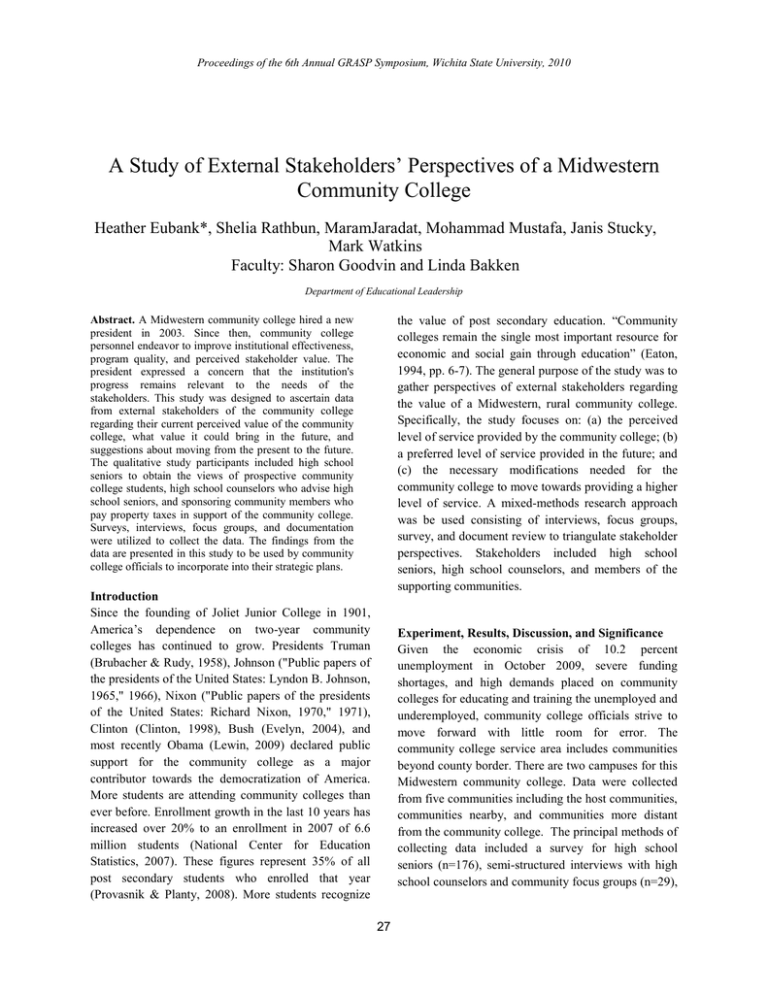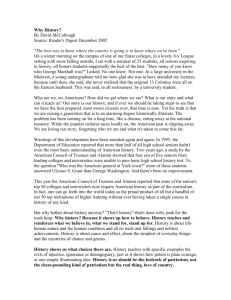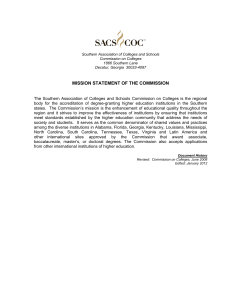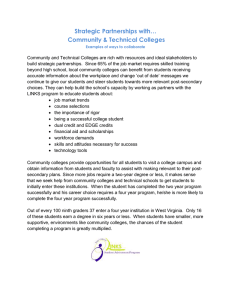A Study of External Stakeholders’ Perspectives of a Midwestern Community College
advertisement

Proceedings of the 6th Annual GRASP Symposium, Wichita State University, 2010 A Study of External Stakeholders’ Perspectives of a Midwestern Community College Heather Eubank*, Shelia Rathbun, MaramJaradat, Mohammad Mustafa, Janis Stucky, Mark Watkins Faculty: Sharon Goodvin and Linda Bakken Department of Educational Leadership Abstract. A Midwestern community college hired a new president in 2003. Since then, community college personnel endeavor to improve institutional effectiveness, program quality, and perceived stakeholder value. The president expressed a concern that the institution's progress remains relevant to the needs of the stakeholders. This study was designed to ascertain data from external stakeholders of the community college regarding their current perceived value of the community college, what value it could bring in the future, and suggestions about moving from the present to the future. The qualitative study participants included high school seniors to obtain the views of prospective community college students, high school counselors who advise high school seniors, and sponsoring community members who pay property taxes in support of the community college. Surveys, interviews, focus groups, and documentation were utilized to collect the data. The findings from the data are presented in this study to be used by community college officials to incorporate into their strategic plans. the value of post secondary education. “Community colleges remain the single most important resource for economic and social gain through education” (Eaton, 1994, pp. 6-7). The general purpose of the study was to gather perspectives of external stakeholders regarding the value of a Midwestern, rural community college. Specifically, the study focuses on: (a) the perceived level of service provided by the community college; (b) a preferred level of service provided in the future; and (c) the necessary modifications needed for the community college to move towards providing a higher level of service. A mixed-methods research approach was be used consisting of interviews, focus groups, survey, and document review to triangulate stakeholder perspectives. Stakeholders included high school seniors, high school counselors, and members of the supporting communities. Introduction Since the founding of Joliet Junior College in 1901, America’s dependence on two-year community colleges has continued to grow. Presidents Truman (Brubacher & Rudy, 1958), Johnson ("Public papers of the presidents of the United States: Lyndon B. Johnson, 1965," 1966), Nixon ("Public papers of the presidents of the United States: Richard Nixon, 1970," 1971), Clinton (Clinton, 1998), Bush (Evelyn, 2004), and most recently Obama (Lewin, 2009) declared public support for the community college as a major contributor towards the democratization of America. More students are attending community colleges than ever before. Enrollment growth in the last 10 years has increased over 20% to an enrollment in 2007 of 6.6 million students (National Center for Education Statistics, 2007). These figures represent 35% of all post secondary students who enrolled that year (Provasnik & Planty, 2008). More students recognize Experiment, Results, Discussion, and Significance Given the economic crisis of 10.2 percent unemployment in October 2009, severe funding shortages, and high demands placed on community colleges for educating and training the unemployed and underemployed, community college officials strive to move forward with little room for error. The community college service area includes communities beyond county border. There are two campuses for this Midwestern community college. Data were collected from five communities including the host communities, communities nearby, and communities more distant from the community college. The principal methods of collecting data included a survey for high school seniors (n=176), semi-structured interviews with high school counselors and community focus groups (n=29), 27 Proceedings of the 6th Annual GRASP Symposium, Wichita State University, 2010 and document reviews. The data were analyzed using the constant comparative method until themes and categories emerged. Particularly, this study provided an appraisal of stakeholder perspectives, allowing community college leadership to identify potential barriers in effective dialogue and to establish valuable relationships in order to provide needed services. There is evidence of differences in perspectives among stakeholder groups. Four major themes resulted from the community focus groups, counselor interviews, and the student surveys as a means to answer the three research questions. These themes were value to the service area; recruitment; outreach; and educational programming. Data garnered from these collection methods will be used by community college officials to offer guidance in the development of long term strategic plans. Conclusions Research indicated that to move forward, dialogue between community college representatives and stakeholders will be critical. For example, data shows that the more distant the stakeholders are from the physical location of the campus, the less engaged they are and as a result the greater the number of negative comments. “…any true understanding is dialogic in nature. Understanding is to utterance what one line of dialogue is to the next…” (Voloshinov, 1973). There are mechanisms in place for communication between the community college and its external stakeholders. Perhaps these could be ameliorated to cultivate dialogic connections for the expressed purpose of nurturing relationships. In this way, the community college could better serve is stakeholders and the stakeholders might perceive more value from the community college. [6] Lewin, T. (2009). A boon to 2-year colleges, affirming their value. New York Times. Retrieved from http://www.nytimes.com/2009/07/15/education/15colle ge.html [7] National Center for Education Statistics (2007). Digest of Education Statistics, from http://nces.ed.gov/programs/digest/d08/tables/dt08_189 .asp?referrer=list [8] Provasnik, S., & Planty, M. (2008). Community colleges special supplement to the condition of education 2008. National Center for Education Statistics, (NCES 2008033), 1-75. Retrieved from http://nces.ed.gov/programs/coe/2008/analysis/2008033 .pdf [9] Eaton, J. S. (1994). Strengthening collegiate education in community colleges. San Francisco, CA: Jossey-Bass. [10] Voloshinov, V. N. (1973). Marxism and the philosophy of language (T. L. Mateika & I. R. Titunik, Trans.). New York: Seminar Press. [1] Brubacher, J. S., & Rudy, W. (1958). Higher education in transition: An American history. Available from http://books.google.com/books?id=0O1yXnXkWIsC&p rintsec=frontcover#PPA234,M1 [2] Public papers of the presidents of the United States: Lyndon B. Johnson, 1965 (1966). from http://www.presidency.ucsb.edu/ws/index.php?pid=273 56&st=Higher+education+act&st1= [3] Public papers of the presidents of the United States: Richard Nixon, 1970 (1971). from http://www.presidency.ucsb.edu/ws/index.php?pid=331 7&st=&st1= [4] Clinton, B. (1998). Text of President Clinton's 1998 state of the union address. Retrieved May 16, 2009: http://www.washingtonpost.com/wpsrv/politics/special/states/docs/sou98.htm [5] Evelyn, J. (2004). Bush praises community colleges but offers few details of job-training plan. The Chronicle of Higher Education. Retrieved from http://chronicle.com/article/Bush-PraisesCommunity/32729/ 28





